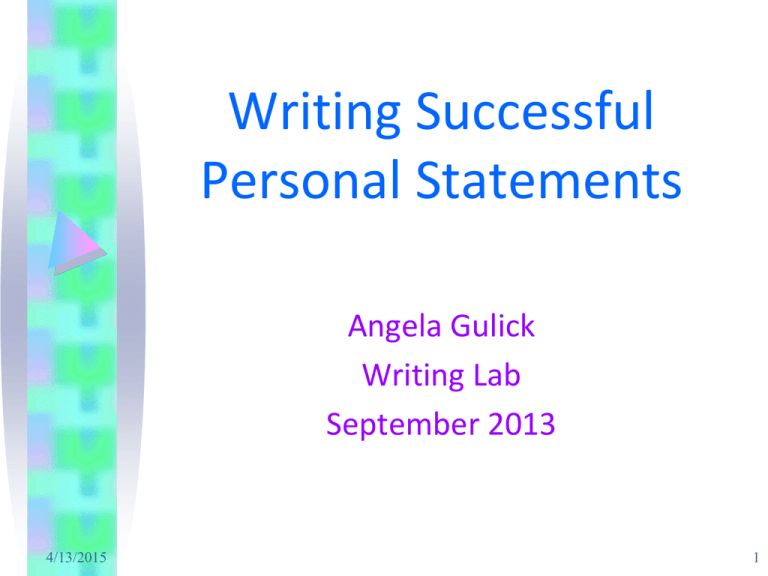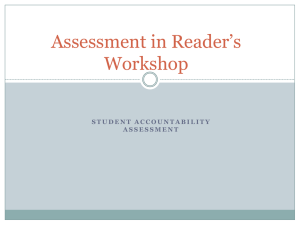Writing Personal Statements Presentation
advertisement

Writing Successful Personal Statements Angela Gulick Writing Lab September 2013 4/13/2015 1 Introduction The purpose of this workshop is to give you tips on writing personal statements for admission to other schools and for scholarships. This workshop has three goals: discuss ways personal statements are used examine tips for crafting successful personal statements mention pitfalls to avoid when writing personal statements 4/13/2015 2 Ways Personal Statements Are Used Personal statements are used to “fill in the gaps” not provided by other documents such as college transcripts, portfolios, cover letters, letters of support Know well what your other documents are telling your reader and try to use your personal statement to either explain something that might cause reader concern or to highlight/showcase something that might get lost in the paperwork. Examples: sketchy academic history, absence from school, extra factors such as full-time work, self-funded education, military experience 4/13/2015 3 Ways Personal Statements Are Used Personal statements are used to show your human side, a side not always clear from grade point averages and extracurricular experiences alone. You are not expected to tell your entire life story in a personal statement, so resist the urge to just write random details and/or grocery lists. We will discuss specific tips momentarily. Remember that school admissions and scholarships are competitive, so you want to be memorable without being frightfully memorable! 4/13/2015 4 Ways Personal Statements Are Used Personal statements are used to show your ability to follow directions. Study the personal statement’s original language very carefully. If you are asked to write 2 pages, write 2 pages. If you are asked to type the document, type the document. Don’t overwhelm your readers with more than they asked for. Look for verbs in the original personal statement directions. If you are asked to summarize, compare, contrast, evaluate and so on, these are specific expectations your readers will have. Bottom line: Give your readers what they ask for! 4/13/2015 5 Ways Personal Statements Are Used Personal statements are used to show your writing, organization, and critical thinking abilities. Remember that in the eyes of a reader, you are your paperwork. Your documents need to do the talking for you. Take extra pains to edit and organize your work for ease in reading. Some readers have literally hundreds of applications to review, so the more user-friendly your personal statement is, the better. 4/13/2015 6 Tips for Crafting Successful Personal Statements Tip One: Read the application materials carefully and answer the question(s) posed. Underline any verbs you see. Pay attention to formatting issues/page lengths. Don’t guess or approximate an answer. If you don’t understand the question or aren’t sure how to answer it, seek outside suggestions (such as the Writing Lab ). 4/13/2015 7 Tips for Crafting Successful Personal Statements Tip Two: Understand what readers want to see. In general, readers want to see people with drive, focus, and a passion for where they are headed next. Readers want to see candidates with a “game plan” or clear purpose. Some readers may wish to see past experiences/knowledge, and some may not. But most readers want to see applicants who know what they want and are prepared to work hard to accomplish these goals. 4/13/2015 8 Tips for Crafting Successful Personal Statements Tip Three: Consider a chronological approach unless given other directions. This approach divides your statement into three sections: Before: What have you done to prepare for career/education? During: What are you currently doing to prepare for career/education? After: What will you do in the future to prepare for your career/education? Note: The following slides offer tips for writing your personal statement. However, keep in mind that you shouldn’t try to accomplish all of these goals. 4/13/2015 9 Tips for Crafting Successful Personal Statements Stage One: Before 4/13/2015 When/how/why did you first develop your interest in career/educational topic? What are some key academic classes you have taken that have helped you? What are some significant readings you have done in this subject? What are some relevant projects you have worked on in your career/educational area of interest? What significant extracurricular projects or activities have contributed to your interests? 10 Tips for Crafting Successful Personal Statements Stage Two: During What are you doing right now that is aiding your academic or career interests? Keep in mind that not all experiences need to be formal academic ones. Do you belong to any organizations or associations? Have you done any job shadowing or internships? Are you doing any outside readings, particularly in relevant academic, scholarly, or trade publications? Are you currently involved in any classes or outside activities that show your on-going commitment and interests? 4/13/2015 11 Tips for Crafting Successful Personal Statements Stage Three: After What are your specific plans for the future, and how will this opportunity (admission to a school, scholarship) help you achieve those goals? How will this school specifically provide you with these opportunities? For example, are there any specific classes, faculty, or programs you want to take or work with at the school you are applying to? What do you think you can offer your school in terms of special skills, background knowledge, diversity, personality. As uncomfortable as it sometimes is, you need to do a bit of selling your reader on YOU. 4/13/2015 12 Pitfalls to Avoid When Writing Personal Statements Pitfall Number One: The Timeline Approach Some students, because they don’t know what readers want, try to provide a bit of everything in the personal statement. Write about fewer topics but write about them in greater detail and analyze them. Instead of analyzing an event, some students just tell a story and think its point or moral is obvious. Don’t assume anything you write is obvious; what is obvious to you may be unclear to another. Remember: Be selective. Transcripts and resumes generally give readers grocery lists of information. Your job is to select significant experiences and make them relevant to the reader. You also need to show the person behind the details. 4/13/2015 13 Pitfalls to Avoid When Writing Personal Statements 4/13/2015 Pitfall Number Two: The Extreme Approach It is a good idea to show aspects of your personality in a personal statement within reason. However, extremes on either side (overly formal or overly informal) can leave readers cold. Overly formal approaches use elevated language, “artificial” expressions that don’t sound natural, jargon, and long and convoluted sentence structures. Overly informal approaches use slang (“street language”), clichés, and inappropriate humor. A rule of thumb: Readers are more forgiving of formality than informality. 14 Pitfalls to Avoid When Writing Personal Statements Pitfall Number Three: The Generic Approach While it is convenient to have a “one statement fits all” approach, this can really backfire. Readers can sniff out a generic statement that has been mass produced and it leaves them cold. Work to customize your personal statement in some way for the specific school or scholarship you are applying to. Do a bit of research on the Internet; find out something about the school or scholarship. Be sincere, but use this information to show you are familiar with this opportunity. 4/13/2015 15 Pitfalls to Avoid When Writing Personal Statements Pitfall Number Four: The “Jerry McGuire” Approach The Jerry McGuire approach is based on the Tom Cruise movie where the character Jerry McGuire yelled again and again, “Show me the money!” Some writers err, with regard to scholarship applications, in only discussing financial need. Financial need is important, but don’t allow it to be all the reader learns about you. One recommendation: discuss financial need at the end of statement. This way, your reader learns something about you before learning about your financial status. However, your letter ends with that information which might stick with the reader. 4/13/2015 16 Some Final Thoughts 1. Have lots of people read over your materials to help you in terms of clarity, correctness, and organization. But be aware the more people you ask, the more advice you will receive. 2. Save all of your statements and other materials. While we don’t encourage you to send out exact duplicates, you can often revise an existing document to meet your new needs. 3. Make use of the Writing Lab; we look at personal statements all the time. Please let us help you with personal statements and other academic and professional writing tasks you have. Good Luck! 4/13/2015 17








